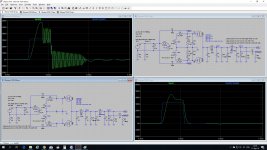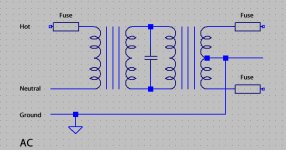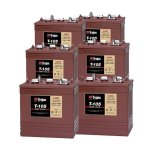Good catch, Gpapag. This is a mistake on the schematic (not my doing) that put a cap in the wrong place. One of the 220uf caps is where you recommend the 10uf cap in the actual Vendetta.
I will come to the defense of the 317, so long as you do not rely on it for audio purity. The following buffer gets rid of the problems (at least the ones I know) by smoothing out the transient response and greatly lowering the noise on the power supply. An open loop buffer is best. Can you guys spot the buffers on the gain cards?
Amorphous, nanocrystaline thems marketing words.
Maybe.
Amorphous & Nanocrystalline-Common Mode Choke Cores
Judging by the graphs in the datasheet it certainly is different than the typical generic ferrite core.
I think PS audio power plants used them in the past. A rather effective product.
I don’t doubt they are good just too much time around marketing types in the past.😉 RFI is a serious issue not just for sound but to ship products these days.
I don’t doubt they are good just too much time around marketing types in the past.😉 RFI is a serious issue not just for sound but to ship products these days.
And of course, if there are ferrites anywhere near audio circuits, the usual anti-ferrite sniping will start.
Re regulators, the standard 78xx series is surprisingly quiet. If you use a split secondary, you can rectify, smooth, regulate and then combine to make a single split supply using the same regulator type. It’s also of course much easier to manage charging currents and layout. The cost is a single rectifier, but you will get that back because the negative regs are usually more expensive.
Re regulators, the standard 78xx series is surprisingly quiet. If you use a split secondary, you can rectify, smooth, regulate and then combine to make a single split supply using the same regulator type. It’s also of course much easier to manage charging currents and layout. The cost is a single rectifier, but you will get that back because the negative regs are usually more expensive.
Last edited:
Great move JC, back to audio design!
I raised the question of EMI/RFI filters some posts ago, and the opinion from trusted parties is to not use them. I have the feeling that's because the slope of the filters is calculated (if at all) for rejection, and the concept of critical damping has been long forgotten, so there's a lot of ringings in the 3 different samples I looked at. On top of that, there's a lot of ferrite coils, and that's evil. And yes, I like snake oil.
After reading MerlinB's book, and going through Mark Johnson's Quasimodo thread, I started thinking that snubbers, like the ones posted by Max Headroom, can (or can be made to) swing both ways by also acting as LPF with the inductances of the transfomer. In the attached SIM, the stimulus is a pulse fed to the primary; you can see what happens when you don't do anything about it on the left, and what a snubber/filter can do on the right. Within this context, the parallel cap's don't do anything useful, so I just put 10p for wiring capacitance.
And ignore the 6X4: I'm doing this for the tube preamp I'm working on. 🙂
I raised the question of EMI/RFI filters some posts ago, and the opinion from trusted parties is to not use them. I have the feeling that's because the slope of the filters is calculated (if at all) for rejection, and the concept of critical damping has been long forgotten, so there's a lot of ringings in the 3 different samples I looked at. On top of that, there's a lot of ferrite coils, and that's evil. And yes, I like snake oil.
After reading MerlinB's book, and going through Mark Johnson's Quasimodo thread, I started thinking that snubbers, like the ones posted by Max Headroom, can (or can be made to) swing both ways by also acting as LPF with the inductances of the transfomer. In the attached SIM, the stimulus is a pulse fed to the primary; you can see what happens when you don't do anything about it on the left, and what a snubber/filter can do on the right. Within this context, the parallel cap's don't do anything useful, so I just put 10p for wiring capacitance.
And ignore the 6X4: I'm doing this for the tube preamp I'm working on. 🙂
Attachments
Great move JC, back to audio design!
I raised the question of EMI/RFI filters some posts ago, and the opinion from trusted parties is to not use them. I have the feeling that's because the slope of the filters is calculated (if at all) for rejection, and the concept of critical damping has been long forgotten, so there's a lot of ringings in the 3 different samples I looked at. On top of that, there's a lot of ferrite coils, and that's evil. And yes, I like snake oil.
After reading MerlinB's book, and going through Mark Johnson's Quasimodo thread, I started thinking that snubbers, like the ones posted by Max Headroom, can (or can be made to) swing both ways by also acting as LPF with the inductances of the transfomer. In the attached SIM, the stimulus is a pulse fed to the primary; you can see what happens when you don't do anything about it on the left, and what a snubber/filter can do on the right. Within this context, the parallel cap's don't do anything useful, so I just put 10p for wiring capacitance.
And ignore the 6X4: I'm doing this for the tube preamp I'm working on. 🙂
People are free to omit things like EMI filtering and ESD protection. Of course, the product probably won't pass compliance testing then and will freak out and emit all kinds of spurious tones when in the presence of a nearby cell phone.
There are tons of articles and application notes on how to calculate damped filter networks for SMPS input and output, as an example. Instead of being lazy and incompetent, a designer could just use Google and figure out how to do it.
Imagine how much less sensitive to cables "high-end" equipment would be if it were properly designed.
I suspect things like snubbers and the sim you are doing are worth more than any amount of silver wire or fancy diodes (which still don't help mitigate the high dV/dT from narrow conduction angle because of overkill amounts of filter capacitance).
Last edited:
... Also, we should use high speed soft-recovery diodes, either as a bridge, or as individual components put together to make a bridge. (D upgrade for Vendetta, from middle 1990's or 25 years ago.) ...
Anyone tried the LT4320 "Ideal Diode Bridge Controller", formerly known as synchronus rectifier? The spec's brag about efficiency, but don't say anything about impulse response.
Right on cue. Ferrites are bad.
Where’s Bruno when you need him . . .
There is a lot of CM HF garbage on the mains from all sorts of non audio related consumer stuff and from power line communications networks. Id rather use a ferrite of some description to block this stuff than let it into an amp or pre.
But, how do you do it? Or is that a trade secret?
��
Where’s Bruno when you need him . . .
There is a lot of CM HF garbage on the mains from all sorts of non audio related consumer stuff and from power line communications networks. Id rather use a ferrite of some description to block this stuff than let it into an amp or pre.
But, how do you do it? Or is that a trade secret?
��
Right on cue. Ferrites are bad.
Where’s Bruno when you need him . . .
There is a lot of CM HF garbage on the mains from all sorts of non audio related consumer stuff and from power line communications networks. Id rather use a ferrite of some description to block this stuff than let it into an amp or pre.
But, how do you do it? Or is that a trade secret?
��
A ferrite sounds good to me. Common-mode choke, too.
My guess is, though, that most equipment that isn't subject to any testing has nothing.
Anyone tried the LT4320 "Ideal Diode Bridge Controller", formerly known as synchronus rectifier? The spec's brag about efficiency, but don't say anything about impulse response.
There have been three (maybe more) designs around that published on here in last couple of months. No one has compared those to a correct snubbed transformer yet, but they look interesting. And great marketing if you can come up with the right buzzzzzzzword.
Anyone tried the LT4320 "Ideal Diode Bridge Controller", formerly known as synchronus rectifier? The spec's brag about efficiency, but don't say anything about impulse response.
Impulse response? Do you mean switching speed? I suspect the graphs in the datasheet could lead you to figure it out based on the gate drive and FET you choose.
I confess I didn't read the doc, but scanning through it, I couldn't find any time related units. Of course, it depends on the external MOS, but the total absence of hyperbole is suspicious.
Regarding buzz, how about combining sync rect and snubbers to brag something along the line of: "... combining cutting edge synchronus technogy and ancient wisdom... delivering cristal clear DC while being quiet as a grave..." 🙂
Regarding buzz, how about combining sync rect and snubbers to brag something along the line of: "... combining cutting edge synchronus technogy and ancient wisdom... delivering cristal clear DC while being quiet as a grave..." 🙂
I confess I didn't read the doc, but scanning through it, I couldn't find any time related units. Of course, it depends on the external MOS, but the total absence of hyperbole is suspicious.
Regarding buzz, how about combining sync rect and snubbers to brag something along the line of: "... combining cutting edge synchronus technogy and ancient wisdom... delivering cristal clear DC while being quiet as a grave..." 🙂
You need to calculate it yourself from the gate drive and the Qg of whatever FET you pick.
Synchronous rectification is nothing new. It's been in use in SMPS forever.
Regarding buzz, how about combining sync rect and snubbers to brag something along the line of: "... combining cutting edge synchronus technogy and ancient wisdom... delivering cristal clear DC while being quiet as a grave..." 🙂
Nah needs something like 'using SmartBridge technology'. If you can find a NASA application for it so you can say 'based on space research' or 'milspec'
so much the better.
RFI filtering, what would you suggest?
Attachments
- Status
- Not open for further replies.
- Home
- Member Areas
- The Lounge
- John Curl's Blowtorch preamplifier part III



